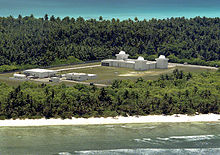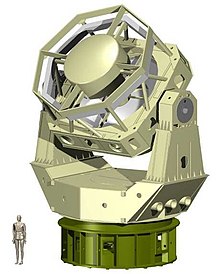Space Surveillance System
A space surveillance system is a network of telescopes and radar systems that is used to maintain a catalog of artificial space objects (operational satellites , space junk ). Systems of this type are currently operated by the United States and Russia . The ESA is building as part of its SSA program on its own monitoring system.
The US Space Surveillance Network (SSN)
This system consists of 17 radars and 8 telescopes. A space-based sensor, the Space Based Visible Telescope, is also used. The number of space objects currently being tracked by the Space Surveillance Network (SSN) is currently around 13,000. However, currently only data for around 8,600 objects are openly accessible. Depending on the orbit, the smallest of the objects in the catalog have a diameter of 5 cm ( near-Earth orbit ) to 50 cm ( geostationary orbit ). Radars are advantageous for nearby objects and optical telescopes for distant objects.

In addition to the search for new objects, the cataloged objects are alternately briefly observed in order to update their path data, several times a day for objects in the vicinity. The large amount of data may come. a. of telescopes ( Ground-based Electro-Optical Deep Space Surveillance for short GEODSS ) on Maui , Diego Garcia , Socorro in New Mexico and of phased-array radars such as Thule , Eglin and Cobra Dane , which are not so sensitive to small objects, but discover larger objects faster thanks to their electronically pivotable beam - a military requirement.
The French GRAVES
GRAVES ( French grand réseau adapté à la veille spatiale ) is a French military radar system that has been in operation since 2005 and is used to determine the orbit of artificial earth satellites .
The Russian SKKP
Russia operates a surveillance system called SKKP ( Russian Система контроля космического пространства ).
See also
Web links
- Space Surveillance DOD and NASA Consolidated US General Accounting Office 1997 (pdf, 44 p., Accessed October 15, 2009; 309 kB)
- GEODSS - Ground Based-Electro-Optical Deep Space Surveillance globalsecurity.org
- Ground-Based Electro-Optical Deep Space Surveillance System
- A GEODSS Sourcebook (pdf, 117 pp., Accessed October 15, 2009, 17 MB) at fas.org
